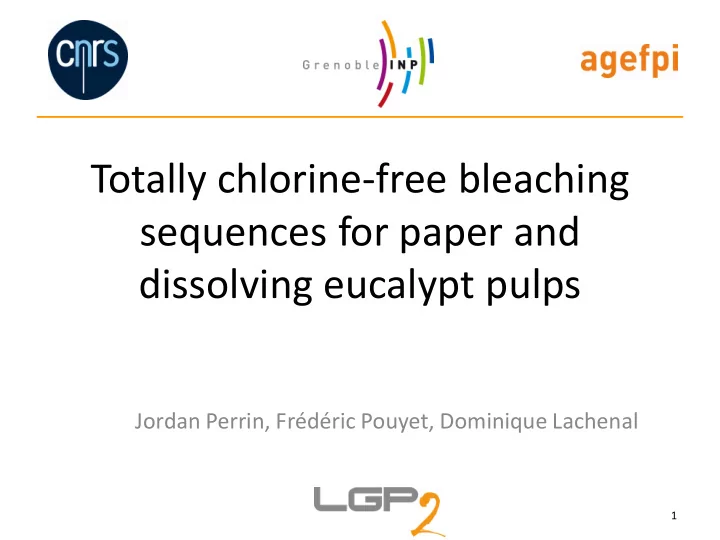

Totally chlorine-free bleaching sequences for paper and dissolving eucalypt pulps Jordan Perrin, Frédéric Pouyet, Dominique Lachenal 1
Introduction Why is TCF not developing? • Quality • Regulation • Cost • ECF bleaching is considered as BAT 2
Introduction • The efficient TCF sequences contain ozone treatment • Cellulose is oxidized by HO° radicals during ozone stage • These radicals are formed by the action of ozone on C=C (HexA, Lignin, oxidized lignin). 3
Principles for better performance • C=C have to be lowered as much as possible • HexA are removed by A stage • Split of ozone charge • Muconic acids are removed by E stage • Final P helps brightness gain and stability →A(ZE)(ZE)…P type sequences are proposed 4
TCF pulp line 5
Bleaching of Eucalyptus paper pulp ClO 2 charge (%) O 3 charge (%) NaOH charge (%) H 2 O 2 charge (%) OXE/T D A (EP)DP 0.55+0.25 / 1.0+0.8 0.35+0.2 917 ZEP / 0.8 1.0+1.0 0.6 1353 A Q (ZEO)(ZEO)P / 0.25+0.18 1.1+1.0+0.8 0.6 890 Brightness (%ISO) DP D A (EP)DP 90.5 1180 ZEP 86 800 A Q (ZEO)(ZEO)P 90.6 1000 • Properties of TCF pulp similar to those of ECF pulp 6
Mechanical properties • Good physical properties for TCF pulp 7
Assessment • Lower OPEX/CAPEX • Lower water consumption • Lower COD/BOD • No AOX • Similar quality to ECF 8
Dissolving pulps Difference with paper pulp: • No HexA • Low viscosity (viscose grade) Constraints: • High reactivity • Narrow molecular mass distribution … 9
Bleaching of Eucalyptus dissolving pulp • Same type of TCF sequences (except A) • Very low chemical consumption H 2 O 2 charge ClO 2 charge (%) O 3 charge (%) NaOH charge (%) OXE/T (%) D(EOP)DP 0.40+0.45 / 1.0+0.5 0.1+0.1 747 Q a (ZEO)(ZEO)(ZP) / 0.1+0.1+0.1 1.0+1.0+1.0 0.2 492 (ZEO)(ZEO)(ZP) / 0.1+0.1+0.1 1.0+1.0+1.0 0.2 492 Brightness (%ISO) DP D(EOP)DP 89.0 745 Q a (ZEO)(ZEO)(ZP) 90.1 640 (ZEO)(ZEO)(ZP) 89.8 620 10
Properties of dissolving pulp • Lower DP • Higher reactivity D(EOP)DP Q a (ZEO)(ZEO)(ZP) (ZEO)(ZEO)(ZP) Brightness (%ISO) 89.0 90.1 89.8 Bright. after ageing (%ISO) 87.9 88.3 87.9 DP 745 640 620 R18 (%) 98.0 98.0 98.0 Fock (%) 75 85 - 11
Properties of dissolving pulp (2) • Similar molecular mass distribution 0.9 0.8 Differential weight fraction 0.7 0.6 0.5 D(Eop)DP Qa(ZEo)(ZEo)(ZP) 0.4 0.3 0.2 0.1 4.5 5 5.5 6 6.5 7 log Mw 12
Chemical cost • Lower chemical cost D(EOP)DP (ZEO)(ZEO)(ZP) (ZEO)(ZEO)(ZP) ClO 2 : 0.85% O 3 : 0.3% O 3 : 0.3% H 2 O 2 : 0.2% H 2 O 2 : 0.2% H 2 O 2 : 0.2% MgSO 4 : 0.1% MgSO 4 : 0.3% MgSO 4 : 0.1% Reagent (%) NaOH: 1.5% NaOH: 3% NaOH: 1% H 2 SO 4 : 0.5% H 2 SO 4 : 1.2% H 2 SO 4 : 1.2% - - OWL: 2% as NaOH Cost ($/T) 17.8 16.2 13.1 O 2 and OWL not taken into account 13
Assessment • Lower OPEX/CAPEX • Lower water consumption • Lower COD/BOD • No AOX • Better reactivity 14
Conclusions New TCF bleaching sequences are proposed for both paper and dissolving pulps. In these sequences the consumption of ozone by the primary lignin oxidation product are minimized (less oxidation of cellulose, better ozone efficiency). These sequences appear attractive in terms of cost and environmental impact. No quality penalty was found so far. 15
Thank you for your attention Acknowledgments: 16
Recommend
More recommend